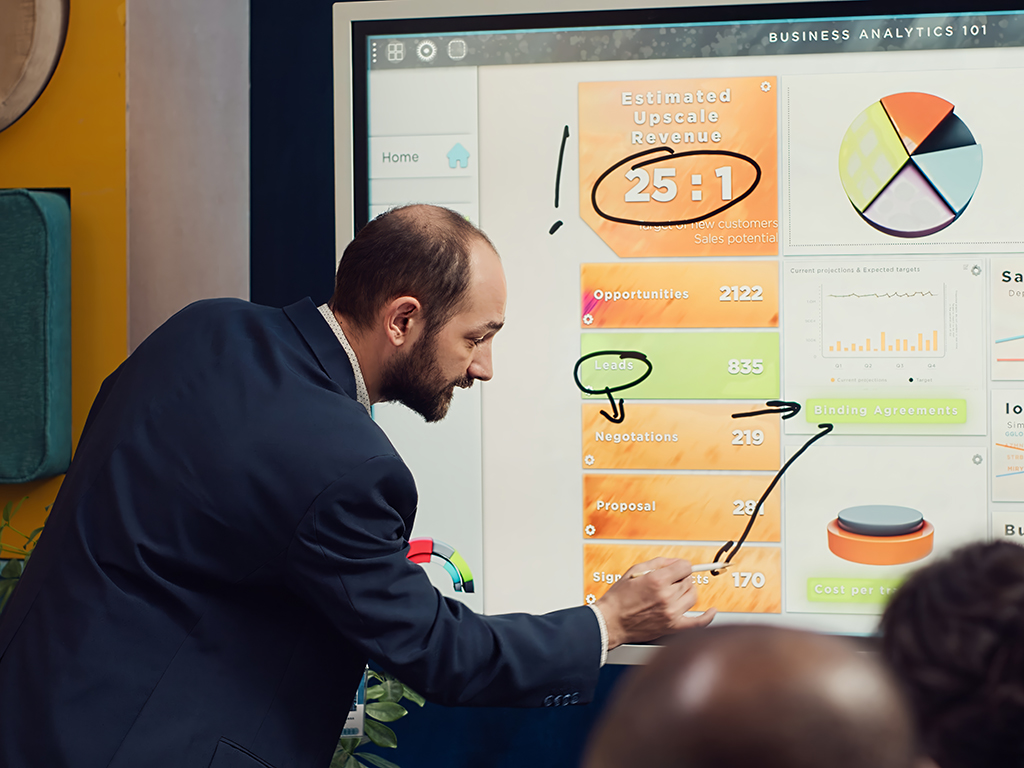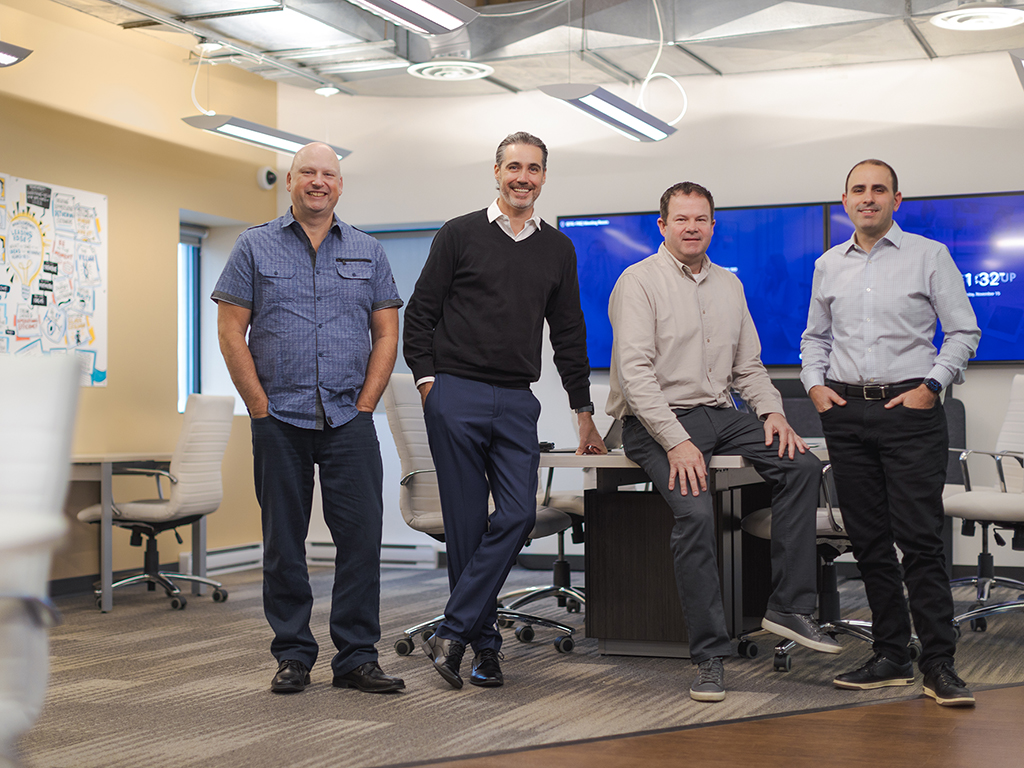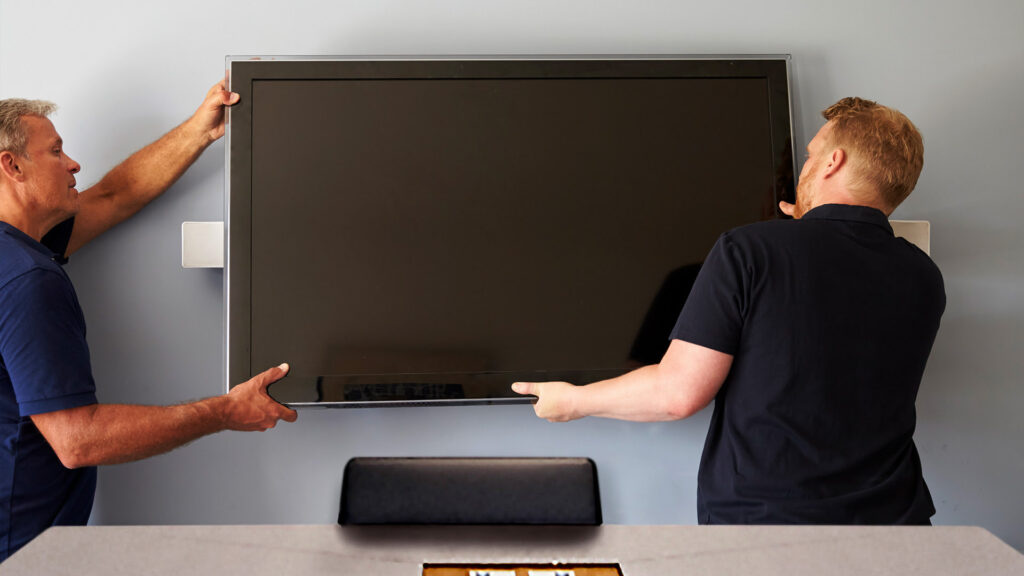The Best Zoom Rooms Hardware for Hybrid Spaces in 2025
Summary:
- Virtual meetings are normal in almost every industry, but not every workspace offers the same experience. Choosing the right equipment for your Zoom Rooms and other purpose-built spaces can help overcome these challenges.
- High-quality cameras, microphones, displays, and control panels play a key role in making meetings feel more inclusive and personal, rather than disjointed and chaotic.
- Technologies like AI-powered speaker tracking, automatic framing, and SMART support can also supplement your hardware to improve real-time collaboration.
- Choosing reputable hardware brands and vendors, like Sennheiser, Crestron, Sharp, Q-Sys, and Yealink can help organizations feel more confident when they invest. Working with a technology consulting firm like ET Group can guide your technology buying for maximum ROI.
- Scalability is essential. As technology evolves, meeting room hardware will need to be agile enough to adapt to changes in the market and trends—like agentic AI, AR, and VR.
Not all meeting spaces are created equal. According to Owl Labs, 86% of workers attend at least one virtual or hybrid meeting per week, yet over 70% still face frustrating technical difficulties that waste time or derail productivity when they do.
Clearly there’s a disconnect—and hardware is a likely culprit. Around 87% in the same study cited hardware as one of the most important factors for work. That makes choosing the right equipment for your Zoom Room more important than ever.
From cutting-edge displays to interactive whiteboards, you’ll discover the best Zoom Rooms Hardware for 2025 in this guide. Take a look, then call us at ET Group for help selecting and implementing the technology that will enhance hybrid work for your organization.
Related: The Rise of the Virtual Meeting Room

The Best Hardware for Zoom Rooms in 2025
Given how fast technology is changing, it’s easy to feel anxious about investing in meeting tech. Most clients naturally want to feel confident in their investment before they make a decision.
While the market is certainly crowded, and every organization’s needs and budget are different, some solutions still stand out from the pack as obviously valuable options. Explore the products listed below to see what we recommend to many of our clients who are looking for ways to improve their hybrid work experience.
- For All-In-One Video Bars: Logitech’s Rally Bar Huddle simplifies the meeting experience by bundling everything you need into one ready-to-deploy package. Built-in features like a 6 DMIC microphone array, advanced digital PTZ camera, and full-range ported speaker make this option ideal for small to medium spaces.
- For Smart Boards: Yealink’s MeetingBoard65 is a robust interactive whiteboard that comes with its own fully integrated cameras, microphones, and speakers. Support for features like premium inking, diagrams, fluid components, and other rich content formats on or offline makes this one useful in virtual and on-site meetings.
- For Crestron Ecosystems: Crestron’s Automate VX is a multi-camera speaker tracking solution that seamlessly connects to Crestron-branded hardware—for example, the 1 Beyond i20 Intelligent PTZ Camera. It automates video switching and audio distribution behind the scenes to improve the meeting experience in larger rooms.
- For Zoom-Specific Control Systems: The Q-SYS Control for Zoom Rooms app sits between Zoom’s Rooms Control API and your cameras, microphones, speakers, displays, and lighting. It gives participants and meeting leaders the power to control all connected equipment from within the same unified interface.
- For Microphones: Sennheiser TeamConnect Ceiling 2 is a deceptively simple ceiling-mounted tile microphone system that works particularly well in larger spaces. A sleek design means it takes up almost no real estate, but still comes with adaptive beamforming and other advanced technologies built-in.
- For Commercial Displays: Sharp’s NEC Displays—particularly the M-series—continue to lead the pack with crystal-clear visuals. It’s available with an optional Raspberry Pi MediaPlayer or an Intel® Smart Display Module (Intel® SDM) for easier media and content playback. Screen sizes range from just 43″ to 75″.
Partnering with the right companies and AV vendors is just as important as the tech you choose to invest in. Providers should be willing to work with you to help you identify and meet your goals without pushing you to close the deal before you’re ready.
Related: What Type of Space Does Your Workplace Need?

Foundational Components Every Zoom Room Should Have
Video conferencing technology is the first and most critical element of any well-designed Zoom Room or purpose-built meeting space. The right combination of equipment makes the meeting experience feel more natural, alive, and personal for all participants.
Focus on these key components in 2025:
- High-quality cameras that make faces and expressions feel more life-like and present, helping everyone feel more connected and engaged. Look for features like Pan-Tilt-Zoom (PTZ), razor-sharp visuals, wide-angle lenses, and next-gen AI.
- Speakers and microphones should fit into the room without taking up too much real estate. Features like beamforming technology, noise cancellation, and automatic speaker switching make even the smallest devices more powerful.
- Displays or touchscreens with the power to serve as a visual backbone for meetings. A large, life-like display can help participants feel like they’re in the same room, while interactive touchscreens make collaborating easier.
- Control or scheduling panels with software that seamlessly integrates your meeting tech and calendar system. They should have the power to automatically monitor and manage bookings, room availability, and equipment settings in real-time.
- Whole-room systems that simplify the process by integrating cameras, microphones, and audio into one cohesive package. These are available in pre-packaged commercial setups and as a product of custom AV design.
Basic components like these still need to be thoughtfully selected and implemented if you want them to match your goals and needs. That’s why we strongly recommend working with our AV design team, who can guide you towards choices that drive user adoption and empower your teams.
Related: Do you Lack Meeting Room Space?

The Most Valuable Features for Competitive Hybrid Work Spaces
For an ideal meeting experience, meeting spaces need to go beyond basic functionality and connectivity—especially when teams are distributed across the globe. These innovative features are already shaping the future of hybrid work:
- Auto-Framing Cameras. Powerful AI-driven camera features can now automatically adjust the focus to track speakers as they change, even when the conversation ebbs and flows. This lets remote participants follow the flow and stay engaged in the discussion.
- Participant Audio Leveling. Advanced background systems adjust individual voice levels on the fly as voices rise and fall—or when people cough. This helps your meeting tech respond to distractions and filter out background noise.
- Touchless and Voice-Activated Controls. Features like one-tap join, voice-activated room control, and gesture-based commands are making Zoom Rooms more accessibility-friendly. They also help reduce the spread of germs.
- Immersive Displays. High-resolution, large-format displays bring meetings to life on the screen for all participants, especially when paired with the right cameras and features. Every meeting feels like a studio production instead of a regular day at the office.
- Shared Annotation Tools. Interactive whiteboards, sometimes called SMART boards, power real-time collaboration between distributed teams. People can brainstorm, edit, and develop the same content in real-time from anywhere.
The core goal of hybrid-supportive features like these is always the same: make the meeting experience feel more accessible and functional for everyone involved. Focus on that first to get it right.
Related: Is Empathy the Missing Link in Tech Integration for Hybrid?

Scalability as a Core Priority
True scalability is about more than expanding a system’s capacity as your organization grows. It means creating flexible, adaptable meeting spaces that evolve with your organization’s needs, no matter what that looks like.
Hybrid workspaces rarely benefit from a one-size-fits-all approach, and what works well for a small startup’s huddle room won’t work in a large corporate boardroom. Here’s a glimpse at what we focus on for clients when scalability matters most.
What Does Scalability Look Like?
Scalability is about so much more than basic flexibility—it means creating an environment that can evolve with your organization’s needs over time. At ET Group, we follow guiding principles that help us design scalable solutions for clients.
- Flexible Infrastructure: Designing meeting spaces with modular hardware and software, like cloud-based Zoom Rooms, makes it easier to scale without costly overhauls.
- Designed for Evolving Workflows: Creating meeting spaces that can support changing team dynamics and workstyles, like hybrid collaboration, helps you scale without a complete redesign.
- Consistent Experience at Any Scale: Employees should enjoy a reliable, intuitive user experience across all meeting spaces—from huddle rooms to boardrooms—so they can seamlessly collaborate no matter where they work.
Focusing on scalability from day one gives you a solid foundation to build on in the future. It might be difficult to predict what the AV industry will look like in a decade, but working with a professional audiovisual consulting firm like ET Group will always be the best way to make the most of your meeting spaces.
Future Trends in Zoom Rooms Hardware
Hybrid work is here to stay. Sensational news articles about pushback in some industries might try to convince you otherwise, but the shift has already taken place—and it isn’t likely to reverse course.
In the future, AR, VR, and agentic AI will make meetings easier and less stressful. Here’s what we predict will happen in these key areas:
Augmented and Virtual Reality (AR/VR)
Prediction: AR and VR tools will continue to redefine how hybrid teams collaborate.
Picture this: you step into your living room and slip on a pair of advanced AR glasses. They blink on, pull you into the meeting, and automatically begin displaying real-time annotations.
Minutes later, you slide your AR glasses off and slip on your VR glasses instead. Now, you’re in a VR environment with colleagues from all across the globe.
Environments like these are closer to reality than you might think. Microsoft’s HoloLens is already capable of running Windows 10 and supporting mixed-reality applications. Companies like Meta and Spatial are actively working on VR environments for commercial use.
Agentic AI: The Next Evolution of Meeting Intelligence
Prediction: Agentic AI will turn Zoom Rooms into proactive, intelligent spaces.
Zoom Rooms and the equipment within them already leverage AI to make meetings more efficient and effective. Agentic AI will enhance the effect by acting proactively and independently on the behalf of all participants in a meeting.
Here’s what that might look like:
- Scheduling will become more streamlined and less hands-on. The AI will automatically monitor schedules and availability, then book meetings and prepare optimized agendas.
- Automatic note-taking will improve, as will real-time translations. The AI will help people work together without worrying about barriers like language or accessibility.
- Task delegation will improve without requiring additional human resources or time. AI will act on its own post-meeting by scheduling follow-ups, assigning tasks, and even drafting emails or project updates based on discussions.
Features like these will help the humans at the center of every meeting and workflow get more done in the time they have—and spend less time stressing over minor details.
Related: Making Your Meeting Spaces Audibly Accessible

Step Into the Future With the Best Zoom Rooms Hardware
Choosing the right hardware for your Zoom Room isn’t about keeping up with trends or maximizing your tech budget—it’s about creating a space that breaks down barriers to help people connect. Meeting tech should align closely with your organization’s goals without negatively impacting the humans that use it day-to-day.
At ET Group, we delve deep into your organization’s unique challenges and stakeholder needs to unlock the full potential of your workplace. Contact ET Group today to discover how we can help you design hybrid meeting spaces that bring your team together and get better results.
Frequently Asked Questions about Zoom Rooms Hardware
What type of hardware do I need to set up a Zoom Room?
The answer depends on your goals and available real estate. For a small huddle room or individual pod, a compact all-in-one media bar with built-in cameras and microphones is a great start. These lightweight, more portable devices save space without sacrificing quality in the process.
In medium or large rooms, a more robust, custom configuration is often better. Dedicated PTZ cameras, distributed ceiling microphone arrays, and large-format displays can help make the meeting experience more equitable from anywhere in the room.
Should Zoom Room hardware be professionally installed?
Some devices, like Shure’s MXW6X Wireless Boundary Microphone, are intuitive and designed for easy use out of the box. But many high-end or enterprise-level systems are extremely complicated and typically require custom integration with the rest of your meeting tech.
In general, we strongly recommend that all organizations work with a technology consulting group before they invest money in meeting tech. Working with our expert AV designers can help lower the cost of testing and iteration and prevent you from making costly mistakes—but it’s also the best way to maximize the potential of any space.
Learn More: Calculate the ROI For Your New Video Conferencing System
Does all Zoom Room hardware need AI-driven features?
Not necessarily. AI-powered features like auto-framing cameras, noise cancellation, and real-time volume adjustments can greatly enhance the meeting experience, but they aren’t a requirement (at least not yet). If your budget is tight or you’re designing a simpler setup—like a small huddle room—your hardware needs may be more straightforward.
AI can be powerful, but it’s still in development and can occasionally leave a lot to be desired. Features like these are more valuable when they align with your organization’s requirements, so give us a call to explore your options and see what technology fits your needs best.
Stay connected with us:
Follow ET Group on LinkedIn
Subscribe to ET Group’s YouTube Channel






